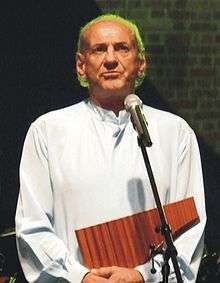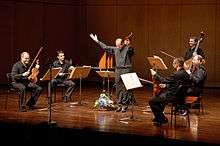Gheorghe Zamfir
| Gheorghe Zamfir | |
|---|---|
 | |
| Background information | |
| Birth name | Gheorghe Zamfir |
| Also known as | Pan Flute Master |
| Born |
April 6, 1941 Găeşti, Romania |
| Genres |
Romanian popular music Instrumental Pop Easy listening |
| Occupation(s) | Musician, Songwriter, Music teacher |
| Instruments | Pan flute |
| Years active | 1960 - present |
| Labels | SonArt, Philips, Mercury |
| Website | www.gheorghezamfir.ro |
Gheorghe Zamfir (Romanian pronunciation: [ˈɡe̯orɡe zamˈfir]; born April 6, 1941) is a Romanian pan flute musician.
Zamfir is known for playing an expanded version of the traditional Romanian-style pan flute (nai) of 20 pipes to 22, 25, 28 and 30 pipes to increase its range, and obtaining as many as eight overtones (additionally to the fundamental tone) from each pipe by changing the embouchure.
He is known as "The Master of the Pan Flute".[1][2]
Career
Zamfir came to the public eye when he was approached by Swiss ethnomusicologist Marcel Cellier, who extensively researched Romanian folk music in the 1960s. The composer Vladimir Cosma brought Zamfir with his pan flute to Western European countries for the first time in 1972 as the soloist in Cosma's original music for the movie Le grand blond avec une chaussure noire. This was very successful, and since then, he has been used as soloist in movie soundtracks by composers Francis Lai, Ennio Morricone and many others. Largely through television commercials where he was billed as "Zamfir, Master of the pan Flute", he introduced the folk instrument to a modern audience and revived it from obscurity.
In 1966, Zamfir was appointed conductor of the "Ciocîrlia Orchestra", one of the most prestigious state ensembles of Romania, destined for concert tours abroad. This created the opportunity for composition and arranging. In 1969, he left Ciocîrlia and started his own small band (taraf) and in 1970 he had his first longer term contract in Paris. Zamfir discovered the much greater freedom for artistic adventure. His taraf consisted of: Ion Drăgoi (violin), Ion Lăceanu (flutes), Dumitru Fărcaș (tarogato), Petre Vidrean (double bass) and Tony Iordache (cymbalum) all number 1 soloists in their country. This taraf made some excellent recordings (CD Zamfir a Paris). He changed the composition of the band soon after: Efta Botoca (violin), Marin Chisar (flutes), Dorin Ciobaru and Pavel Cebzan (clarinet and tarogato), Petre Vidrean (bass) and Pantelimon Stînga (cymbalum). It is said that this change was made to increase the command of Zamfir and have more artistic freedom. A turning point was the recording of Zamfir's composition "Messe pour la Paix" (Philips). His taraf joined a choir and a symphonic orchestra. This was evidence of the growing ambition. While the Philips recordings of that time were rather conservative, Zamfir preached revolution in the concert halls with daring performances. Some say that this short period was the highlight of his career. In 1977, he recorded "The Lonely Shepherd" with James Last. Zamfir put himself on the world map and since then his career became highly varied, hovering over classical repertoire, easy listening and pop music.
Zamfir's big break in the English-speaking world came when the BBC religious television programme "The Light of Experience" adopted his recording of "Doina De Jale", a traditional Romanian funeral song, as its theme. Popular demand forced Epic Records to release the tune as a single in 1976, and it climbed to number four on the UK charts. It would prove to be his only UK hit single, but it helped pave the way for a consistent stream of album sales in Britain. His song "Summer Love" reached number 9 in South Africa in November 1976.[3] In 1983, he scored a No. 3 hit on the Canadian Adult Contemporary chart with "Blue Navajo," and several of his albums (including 1982's Romance and 1983's Childhood Dreams) have charted in Canada as well. [4]
After nearly a decade-long absence, Zamfir returned to Canada in January 2006 for a seven-city tour with the Traffic Strings quintet. The program included a world premiere of Vivaldi's Four Seasons for PanFlute and string quintet arranged by Lucian Moraru, jazz standards, and well-known favourites.

In 2009, Zamfir was sampled by Animal Collective in the song "Graze" on their EP Fall Be Kind.
In 2012, Zamfir performed at the opening ceremony of the 11th Conference of Parties to the Ramsar Convention at the Palace of the Parliament in Bucharest, Romania.[5]
Soundtracks
His first appearance as soloist interpreter in a movie soundtrack was in Vladimir Cosma's 1972 Le grand blond avec une chaussure noire, whose soundtrack became a worldwide hit.
Another of his notable contributions was to the soundtrack of the classic 1975 Australian film Picnic at Hanging Rock. His other film scores include La guerre du pétrole n'aura pas lieu (1975) and the Moroccan film Bodas de Sangre (1977).
He was asked by Ennio Morricone to perform the pieces "Childhood Memories" and "Cockeye's Song" for the soundtrack of Sergio Leone's 1984 gangster film Once Upon a Time in America. His performance can also be heard throughout the 1984 film The Karate Kid.
One of Zamfir's most famous pieces is "The Lonely Shepherd", which was written by James Last and recorded with the James Last Orchestra, and first included on Last's 1977 album Russland Erinnerungen (Memories of Russia); it was also released as a single. "The Lonely Shepherd" was used as the theme for the 1979 Australian miniseries Golden Soak. It was also featured in Quentin Tarantino's 2003 film Kill Bill: Volume 1 and in Nikolas Grasso's short film Doina.
His song "Frunzuliță Lemn Adus Cântec De Nuntă" ("Fluttering Green Leaves Wedding Song") appears in the1991 Studio Ghibli film Only Yesterday.
Personal life
Zamfir was born in Găeşti, Romania, on April 6, 1941. Although initially interested in becoming an accordionist, at the age of 14 he began his pan flute studies with Fănică Luca at the Special Musical School no. 1 in Bucharest. Later he attended the Ciprian Porumbescu Conservatory. He currently resides and teaches pan flute in Bucharest. His son, Emmanuel Teodor (who resides in Montreal, Canada), is also a drummer/musician.
Bibliography
Zamfir has written an instructional book, Traitė Du Naï Roumain: méthode de flûte de pan, Paris: Chappell S.A., 1975, ISBN 88-8291-286-8, and an autobiography Binecuvântare şi blestem ("Blessing and Curse"), Arad: Mirador, 2000, ISBN 973-9284-56-6.
References
- ↑ King of the classics
- ↑ Contemporary Musicians | Zamfir, Gheorghe Archived September 19, 2007, at the Wayback Machine.
- ↑ http://rock.co.za/files/springbok_top_20_(Z).html Retrieved 11 October 2013
- ↑ https://www.collectionscanada.gc.ca/rpm/028020-119.01-e.php?&file_num=nlc008388.6218&type=1&interval=20&PHPSESSID=l5mar6d16v3n4thesedivjds82
- ↑ IISD RS @ Ramsar COP11, Bucharest, Romania: Highlights for July 6
External links
- Official Website [Under constructioned]
- Official Facebook Page
- Zamfir at AllMusic
- Gheorghe Zamfir at the Internet Movie Database
- Henk Jansen: Zamfir and his artistic success